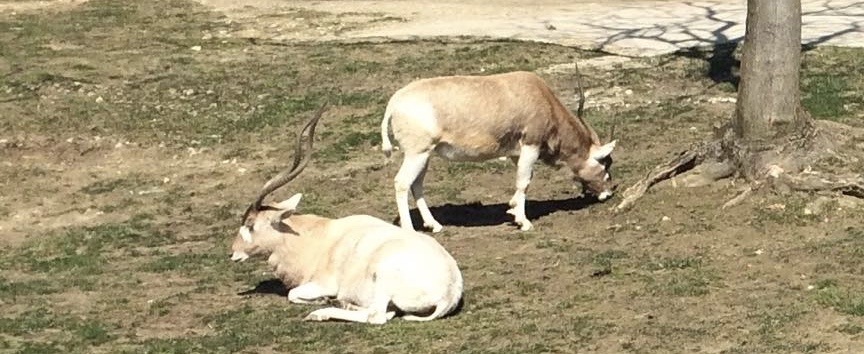Scientific name: Addax nasomaculatus Type of Animal: Antelope Habitat: Desert, semi-desert, thorn scrub, arid plains, dune fields, sandy basins/depressions, arid grassland, arid savanna, steppe Location(s): Once ranged in much of N. Africa. Now found in pockets of Chad, Niger, Mali, & Mauritania w/ reintroductions into Tunisia & Morocco. Introduced into areas of Israel’s Negev Desert. Appearance: Medium-sized antelope with spiral, sharp horns, mostly white coat with a few brownish areas, both sexes bear horns & have similar appearance, horns same length in both sexes but males have thicker horns. Food/Diet: Desert grasses & shoots, tubers, succulents, desert leaves & herbs Status in Wild: Critically Endangered Conservation: Breeding in zoos, wildlife parks, & ranches. Reintroduction programs into North Africa. Introductions into Israel’s Negev Desert. Lifestyle: Nowadays, herds comprise of a male w/ his harem of 2-30 females and calves, and sometimes 3-8 subordinate males. Other males form bachelor herds of 3-8 animals. In the past, many herds would aggregate in herds of up to 100 addax, sometimes up to 1,000. Group: Herd Called: Male: Bull Female: Cow Young: Calf Weight: Male: 220-275 lbs Female: 132-275 lbs Young: 10.5-15 lbs Gestation: About 8-9 months Life Span: 19-20 years Height: Male: 3.5-3.8 ft Female: 3.1-3.6 ft Body Length: Male: 5-5.5 ft Female:Same Tail Length: Up to 1 ft Same for both male & female Additional Info: •Formerly, main addax predators were lions, leopards, hyenas, & cheetahs. Nowadays, crocodiles & pythons will prey on addax if given the opportunity. Large eagles will take calves. •Addax almost extinct in wild due to hunting for horns/hide/sport/meat, competition w/ livestock, extension of pastoralism into habitat, habitat loss, drought, civil war, & oil industry activities. •Many reintroductions into wild areas were captive-bred animals. •Largest captive populations are in Texas ranches. •These animals very popular in hunting ranches in Texas. •There’s way more of these animals in captivity than in wild. There’s probably less than 50 in the wild while there’s between 5,000 & 6,000 in captivity, w/ about 600-700 in captive breeding programs. •Sometimes called “white antelope” & “screwhorn antelope.” •Both sexes sexually mature at 2 years old. •Long, flat splayed hooves act like snowshoes preventing them from sinking into deep sand. •Nocturnal in hottest times of year. •Often excrete dry feces & concentrated urine due to using every bit of water derived from food. •Often dig depressions into sand to rest. Fun Fact(s): -Addax get water from food eaten, meaning they rarely drink. -Addax and close relative the oryx basis for unicorn myth. -They often have a rather aggressive temperament. Females especially protective of calves.

